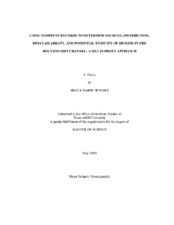| dc.description.abstract | Urban centers are major sources of contaminants to the surrounding air, water and soils. Above all, combustion-derived carbonaceous aerosols, especially black carbon (BC) and associated polycyclic aromatic hydrocarbons (PAHs), make significant contributions to the pollution in these systems. Here sedimentary records are used to produce a series of historical reconstructions of such contaminants to the Houston Ship Channel (HSC) system and compare these to point source inputs of hydrophobic organic contaminants (HOC). Analytical data on total organic carbon (TOC), BC, PAHs, dioxins and lignin (likely discarded from a pulp and paper mill along the Channel) were determined. This multi-proxy approach revealed that over the last several decades, HOC inputs to the system have been derived from a complex mixture of combustion processes, industrial point-sources, and oil spills. In particular, widespread dioxin contamination was observed throughout the study region with a particular site of the HSC showing total concentrations over 20,000 pg/g and 5000 pg toxic equivalent (TEQ)/g dry weight of sediment. Using two models based on sorption constants of total OC and BC, porewater concentrations were estimated to be lower than expected, at 20 pg/L and 5 pg TEQ/L. These values, however, are recognized as being extremely high for freely dissolved concentrations in porous media. The pulp and paper waste pit has recently been declared a Superfund site based on dioxin concentrations alone. The relationship between lignin biomarkers and dioxins observed in these sediments confirms that discharges of pulp and paper effluents were responsible for such high dioxin levels. Concentrations of BC, amorphous OC, and TOC were then used to calculate sediment binding of dioxins in sediments of the HSC. Our study found BC to be extremely low in HSC sediments (0.04 to 0.20%) indicating minimal dioxin sorption capacity. This suggests strong potential for fluxes of dioxins from sediments to the water column both through passive diffusion and physical mixing during natural and anthropogenic sediment remobilization events in this shallow system (hurricanes, storms, and dredging). The purposeful addition of BC to these sediments might be promising as a remediation strategy. | en |


